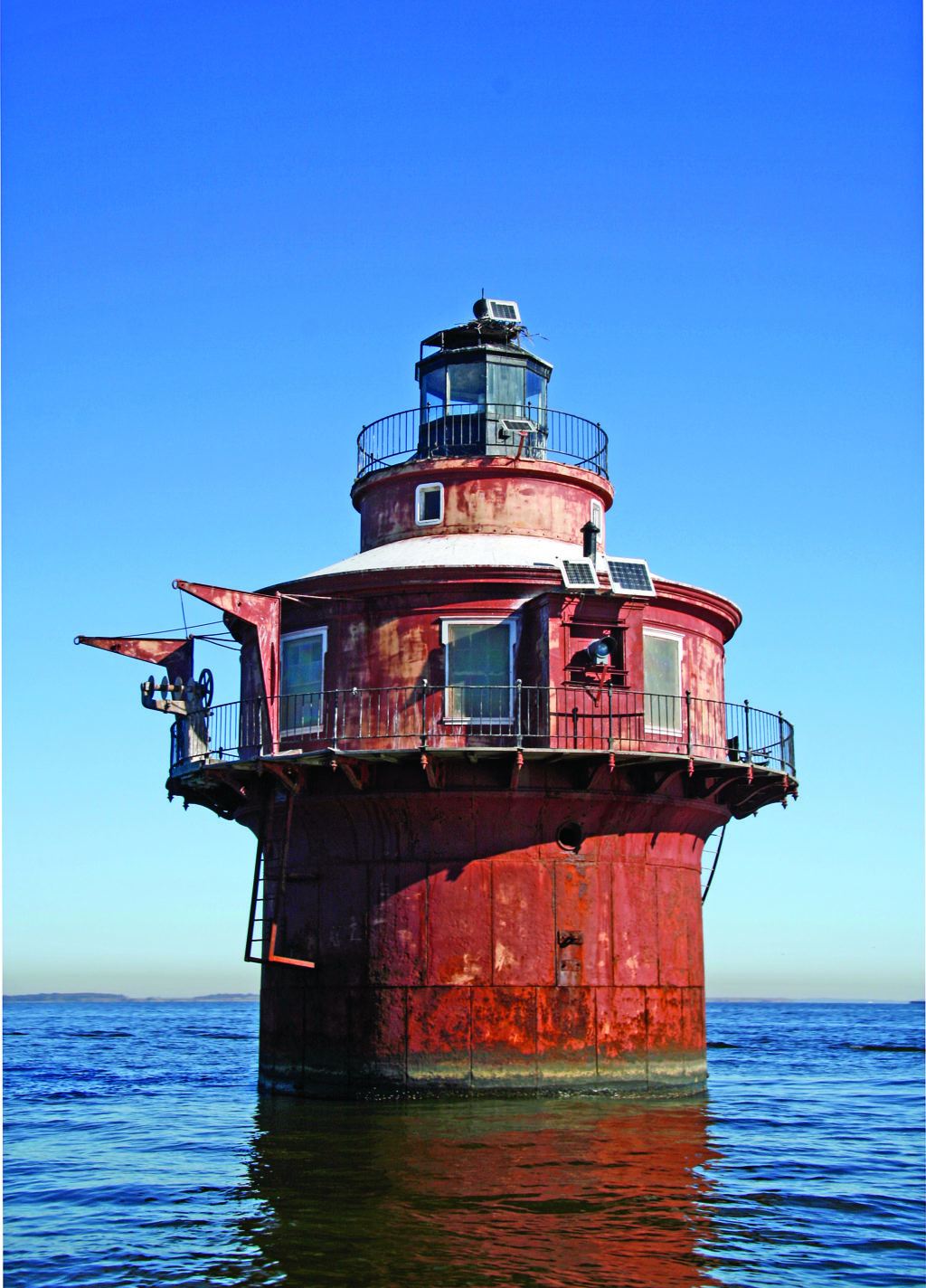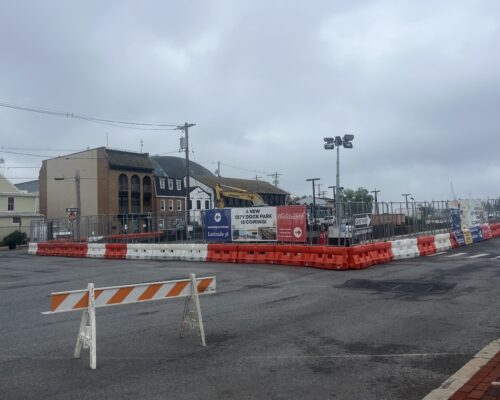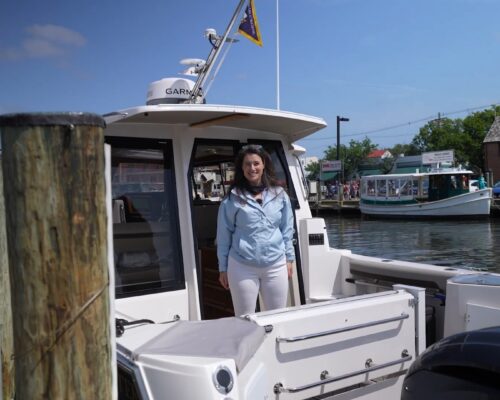They’re the ultimate in waterfront real estate and historic to boot. But owning a Chesapeake Bay lighthouse is not for the faint of heart or wallet.
It’s not easy touching the face of history. From the bow of Cathy Taylor’s “banana boat,” a 17-foot Chiquita-colored inflatable, the prospect seems more than a little scary this morning as we bob alongside Craighill Channel Light and prepare to climb its massive caisson. Picture Jack sizing up a rusty beanstalk. That’s us.
Erected in 1873 to guide ships approaching the Patapsco River from the south, Craighill Channel Lower Range Front Light (its official name) is the second oldest caisson light in the nation. It has withstood time, saltwater, hurricanes and ice floes, yet human neglect threatens to doom it. The one-story keeper’s dwelling, perched 20-some feet above our heads, was abandoned more than 40 years ago. Unless you’re a seagull, accessing its dusty confines these days is tricky, to say the least.
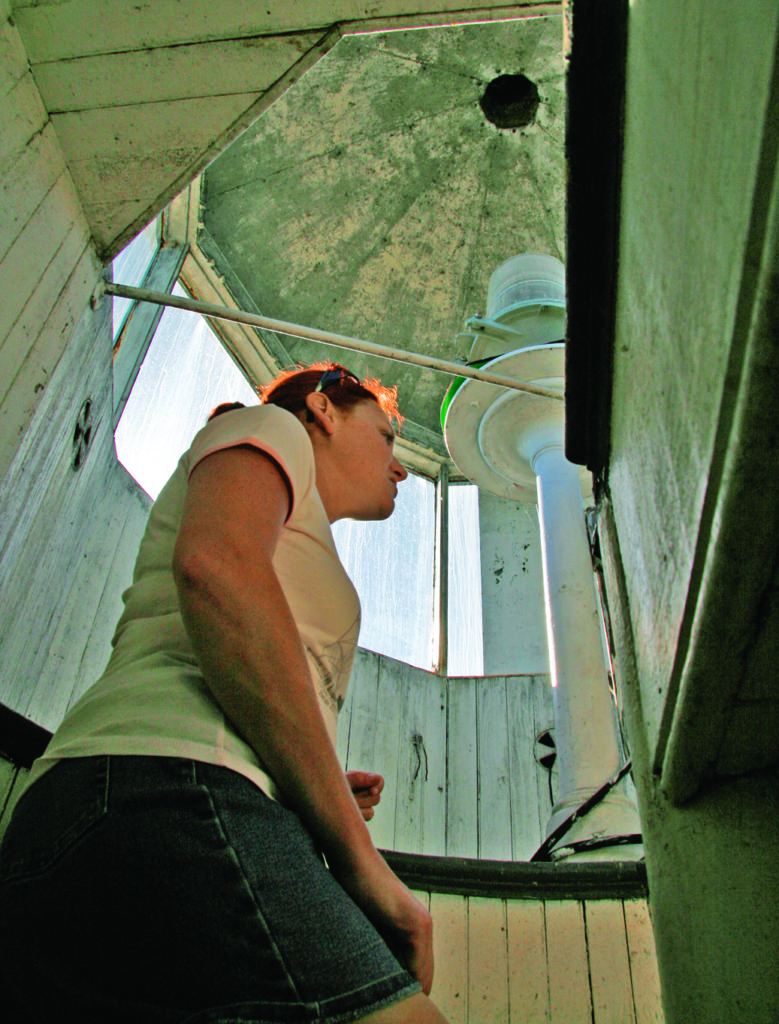
The intrepid Taylor, a crimson-haired computer specialist and mother of two, acquired the lighthouse in 2006 from the federal government and has since made numerous working trips like this one. Maneuvering the boat towards a rope dangling from a corroded platform, she grabs the strand and pulls us closer to the light’s cast iron base. A boarding ladder once extended below the waterline here, and the lighthouse had davits on two sides for the keeper’s tenders. The davits are inoperable and the metal ladder long gone, so after tying off the inflatable we must shinny up a rope ladder to the platform five feet overhead.
Taylor goes first. “Wait, Tyler!” she instructs her 10-year-old son—too late—as he follows close on her heels. A longer fire escape ladder is deployed for the less nimble (me). Knuckles blanching, I proceed cautiously as the ladder twists and the Bay sloshes just below me. Once we reach the platform, it’s a safer climb up a fixed ladder onto the main deck. Here I can begin to sense what’s glorious and odious about light-keeping. The smell hits me first, of fish that’s been seabird-processed and sun-baked. But even the pungency of skeletal fish leftovers and guano can’t overpower the stunning 360-degree vista of bright blue sky and vast gray-green water.
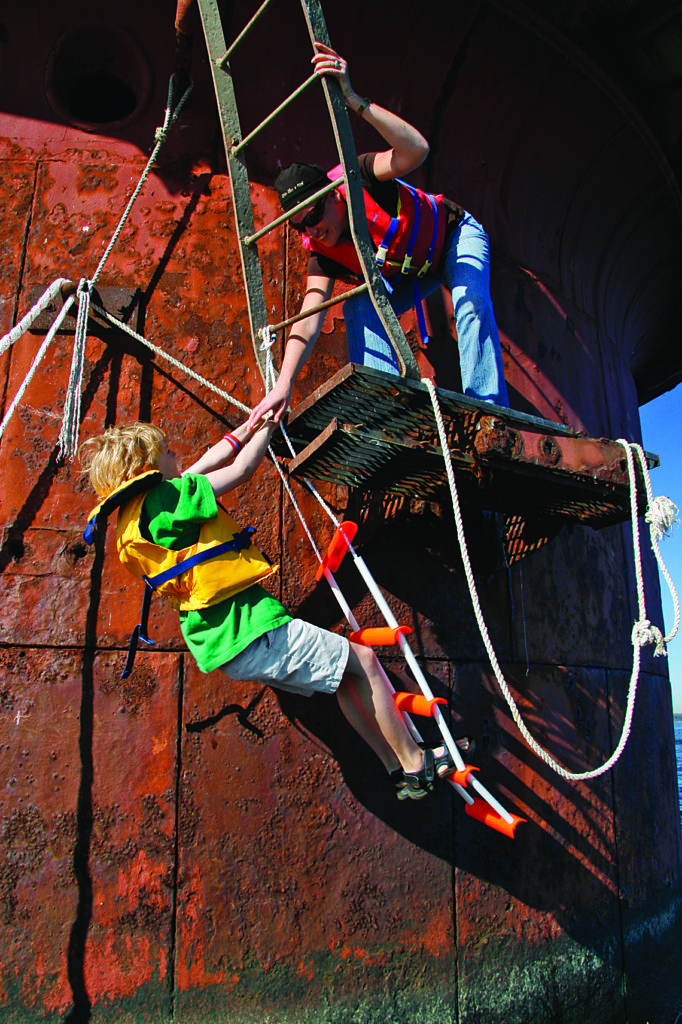
Last night, after hauling up supplies and dining on Sloppy Joes heated on their backpackers’ stove, mother and son slept on the pantry floor, listening as the wind strummed eerily on the davits’ tension braces. (Taylor’s six-year-old daughter Ashlin isn’t along for this trip, but when she is here, her job is dispatching spiders for her father, who’s not fond of them.) Cathy says she awoke early and wandered onto the deck—breezy nights entail frequent checks on the tethered boat and therefore fitful sleep—only to glimpse a shower of meteors brushing the predawn sky.
Despite the beauty of its neighborhood, the lighthouse clearly will require many more slumber-and-work parties. Its faded red exterior hasn’t seen a paintbrush in decades. The decks and railings are nearly whitewashed with bird droppings. In the vacant living quarters strips of white, lead-based paint the size of my palm blister off the walls. Rainwater has rotted ceiling boards in the second-floor watchroom.
Hanging lopsidedly in the cellar, a now powerless electrical box hints that someone once lived and labored here, that we are traipsing through more than a century of maritime history. As a new breed of Bay lighthouse keepers like Taylor is discovering, though, the romance of that long-ago life is matched only by its rigors.
These adventurous souls and their families, whose eldest member is a spry 86 and whose youngest is just toddling, are proving that with love and Rustoleum you can make a lighthouse a home again. They’re spending their free time and, in some cases, their disposable income, patching roofs and replacing windows, installing heads and fashioning showers, cooking meals and sleeping over. Some spouses are eager partners; others rarely set foot on their impetuous half’s creepy, comfortless fixer-upper. As one lighthouse-owning couple likes to say: “We don’t have a life, we have a lighthouse.”
The Coast Guard has been getting out of the lighthouse keeping business since taking custody of them from the U.S. Department of Commerce in 1939. When the lights became automated by new-fangled technology like electricity, installed in the 1920s and ’30s, and solar collection, introduced by the 1980s, they required less human attention. As aids to navigation the lights remained useful, but the houses as dwellings did not. What to do?
Decommissioned lighthouses were torn down or carted off to museum grounds to be preserved and publicly displayed. But 300 active historic lighthouses—those protected by being on, or eligible for, the National Register of Historic Places—languished except for periodic Coast Guard visits to maintain the lamps and related equipment. Prey to vandals and the elements, beacons that saved lives needed saviors of their own.
Since 2000, when Congress enacted the National Historic Lighthouse Preservation Act, Uncle Sam has handed over deeds to 10 Chesapeake lighthouses—six in Maryland and four in Virginia. A few have been conveyed as the law envisioned, gratis to local governments (such as Thomas Point Shoal Light to the City of Annapolis) or nonprofits (like the one Taylor formed, Historical Place Preservation Inc.) that will open them to the public. The remainder have been sold—for up to a quarter million dollars—via online auctions to citizens with a soft spot for maritime landmarks and quintessential waterfront living. Conveyed or sold, the structures come with significant limitations, among them no docking facilities, running water or toilets, a previous tenant (the Coast Guard) who can drop in unannounced, and the equivalent of a fussy landlord in government preservationists who must okay all significant repairs.
Combine these encumbrances with the lighthouses’ deteriorating state and the question often asked of their owners is, Are you nuts?
“I would really love to hear my grandkids say one day, Grandpa must have been crazy to buy that lighthouse,” admits Peter Jurewicz, an electrician from Smithfield, Va. He’s only half joking when he talks about his “thirty-year plan” to restore and transform Hampton Roads’ Thimble Shoal Light into what he calls Pete’s Offshore Retreat.
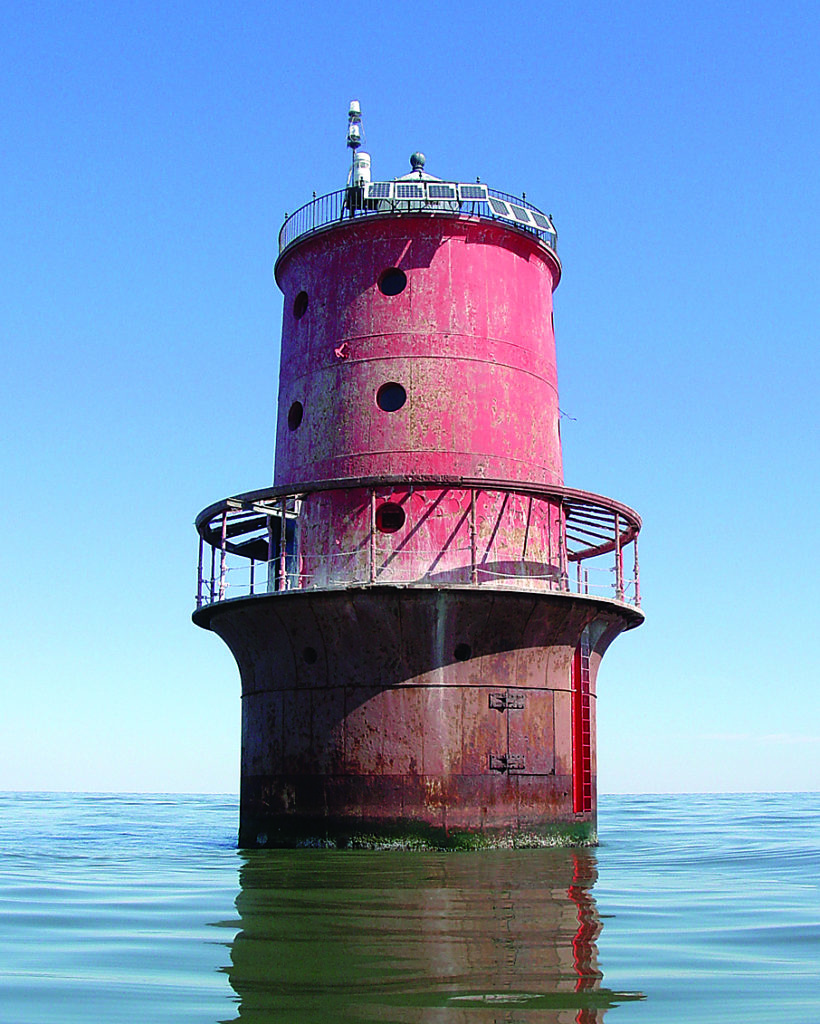
His wife never expected his final $65,000 offer would top the General Services Administration’s online bidding for Thimble Shoal, one of four Virginia beacons the GSA auctioned simultaneously in 2005. Neither did he. When the auction closed he told their daughter, Shelby, “I got good news and I got bad news. The good news is we got the lighthouse.” What’s the bad news, the 10-year-old wondered. “We got the lighthouse and you gotta tell your mom,” he replied.
To preserve marital harmony, Jurewicz will only say he’s spent “an undisclosed amount” refurbishing his 1914 lighthouse. It helps that he’s handy. He designed, built and assembled a boat hoist that addresses the Achilles heel of offshore lighthouse ownership, safe access. The lighthouse has, he says, “become a catalyst in everything I do.”
With her family, her career and her baseball blog (she’s “Miss Chatter” to Washington Nationals’ fans), Cathy Taylor didn’t need a new project—certainly not another restoration after she and husband Kent bought a fixer-upper Victorian in northern Virginia six years ago. When the opportunity to claim Craighill Light presented itself, however, she couldn’t decline. She explained why when we first met, months before our trip to the lighthouse, at her Falls Church home.
“I had to do this or I’d always regret it,” said the 35-year-old, a lighthouse addict since the days she and a friend used to paddle kayaks to Egmont Key Light in Florida, where she attended college. “I just thought, wow, there’s a program where you can save a lighthouse and open it to the public? How neat would that be?”
She applied for custody of Craighill Light in 2002, got an inspection tour from the Coast Guard (“I prepared myself for the worst”), survived the feds’ rigorous vetting process and, three years later, was handed the lighthouse keys—a symbolic gesture since the lock had been vandalized and anyone could enter.
Her nonprofit has six other board members, with experience in everything from grant writing to engineering, but Taylor has supplied most of the labor, along with whichever family members, friends and lighthouse devotees volunteer. She needs to raise about $500,000 to fix it up and has already spent a small personal fortune on boats. The first, in addition to frequent breakdowns, endured repeated lighthouse bashings. The yellow inflatable, a dive boat purchased on eBay, is much smaller but more workable than its predecessor. “It runs, it’s rubber and it’s not going to break,” she says.
I’d heard—and read—about one of Taylor’s scarier boating misadventures, when she and Tyler were, as he puts it, “lighthouse-wrecked” one afternoon by high seas that prevented them from reboarding their first boat, a 25-foot cabin cruiser. Like the keepers of old, Taylor maintains a log. Hers, though, is electronic and colorful—a blog on Craighill Light’s website, craighillrange.org. The entry that day describes the low point of the afternoon, when a large swell lifted the boat’s bow and smashed it into the lighthouse platform. “I watched in horror as the railing split and screws flew while the base popped out on both sides of the hull. ‘Mommy!!! You’re breaking the boat!!’ Tyler squealed….” (A tow boat came to their aid and escorted boat and owner back to their Millers Island marina.)
Tow boat operators aren’t the only support network the nouveau lighthouse owner can call upon. The Chesapeake Chapter of the U.S. Lighthouse Society, an educational group that manages Thomas Point Light, reaches out to owners, offering estimates of restoration costs, referrals to preservation experts and even helping hands. Chapter-recruited volunteers trained in lead paint removal are slated to clean Craighill Light later this year.
Among those the chapter has advised are the owners of Baltimore Harbor Light near the mouth of the Magothy River. Perhaps the most coveted beacon on the Chesapeake auction block, the 1908 caisson-style light has what you might call good bones. “It’s beauuuuu-tiful inside. I have to admit I had lighthouse envy,” Taylor says of her southern neighbor.
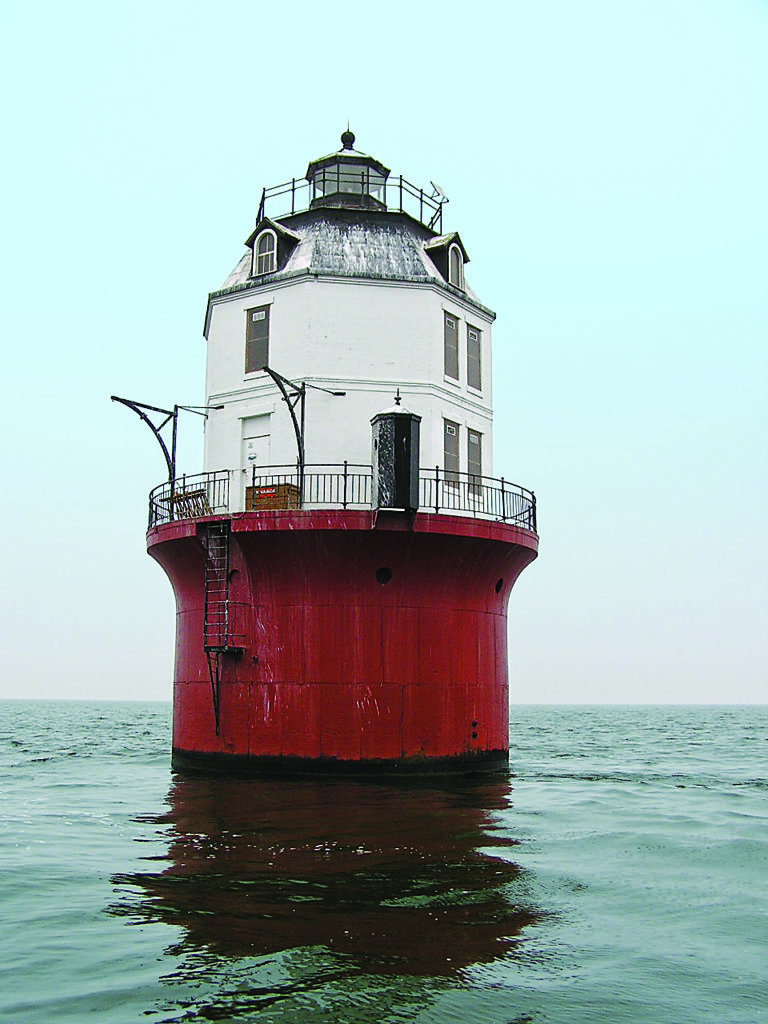
The octagonal brick cottage’s tongue and groove paneling and spiral wooden staircase were never painted, nor was its exposed interior brickwork. The original galley sink and wooden drain board remain in place, a rarity in mothballed light stations, which are generally stripped to the floorboards. So impressed with its pristine condition was a visiting preservationist that he kissed a wall. “It’s pretty amazing,” says Joe Gibson, one of its owners. “It’s like a time capsule.”
Four married couples who live and/or work in Annapolis bought the lighthouse in 2006 for $260,000, the highest price paid at auction to date for a Bay lighthouse. Their purchase has already returned priceless memories, they say.
On the day the new owners received the keys, for instance, one couple couldn’t make the trip, heading for the delivery room instead. Marni Grimm’s and Ron Katz’s beacon baby, Dylan, nearly two years old now, has become known as “the lighthouse heir.” On another occasion, while enjoying celebratory champagne on their first lighthouse overnighter, the group received a surprise Coast Guard visit. This time the Coasties weren’t bearing keys. “That’s johnny law coming,” Mark Jeffries remembers telling his friends as a patrol boat closed in with flashing lights and an amplified warning: “Disembark the light now!” “No, it’s ours,” they protested. Rightful ownership was finally sorted out and the Coast Guard departed.
(Jurewicz had an even scarier encounter at Thimble Shoal last year when a Coast Guard patrol escorting several Navy carriers into Norfolk mistook the 55-gallon barrels of water he was hoisting onto the lighthouse. Sensing something sinister, the patrol boat zoomed towards them, 50-caliber machine guns poised. “I saw those guys draped over those fifty-cals and I was scared to death,” Jurewicz recalls.)
Poking around the cellar and three floors of rooms, Baltimore Harbor Light’s owners have uncovered mostly good news—many original doors and moldings, no lead paint, only moderate water damage—a switch from the lighthouse’s historic trail of woe, which began in 1902 when the caisson capsized while under construction and the contractor subsequently went bankrupt. These days the light has hosted 20-some people for work parties resembling backyard barbecues, complete with a pot of shrimp boiling on the grill, a friendly pooch under foot (owners John and Amee Russell’s yellow lab, Severn), even a lighthouse “garden” gnome.
The Victorian-era outhouse, which cantilevers off the main deck, has been converted into an eco-friendlier outdoor shower. Other comforts, like a Purisan toilet system and a small fridge, are forthcoming, but nothing too lavish; the goal is preservation not modernization. “We don’t want to go ‘Pimp My Light’,” Jeffries says.
While the Lighthouse Society takes no official stand on private ownership of lighthouses, Chesapeake Chapter president Anne Puppa worries that owners’ romantic attachments may fade over time. “Once the bloom is off the rose are they still going to be interested [in maintaining it]? In some cases obviously yes,” she says. “But even nonprofits lose traction.”
Henry Gonzalez, vice president of the U.S. Lighthouse Society and manager of Thomas Point Light, still believes the NHLPA’s public-private partnerships can work: “I’d rather see [a lighthouse] go into the hands of a well-intentioned private owner than continue to decline.”
Auctioned lighthouses carry covenants protecting the historic structure’s distinctive features and materials, but latitude for personal style and usage remains, as the owners of Newport News Middle Ground Light have proven. The Gonsoulin and Billingsley families of Williamsburg and Annapolis, respectively, transformed their bargain (they paid only $31,000 for Virginia’s oldest remaining caisson light) into a comfortable, rehabilitated retreat for their extended families.
Having a naval architect and four engineers among them certainly helped. The lighthouse’s condition was deplorable; it leaked badly, pieces of the balustrade had fallen off, chunks of first-level deck plating were gone and bird droppings hung like stalactites from ladders. Still, something about it caught Bob Gonsoulin’s eye. “It was more a traditional light to me.”
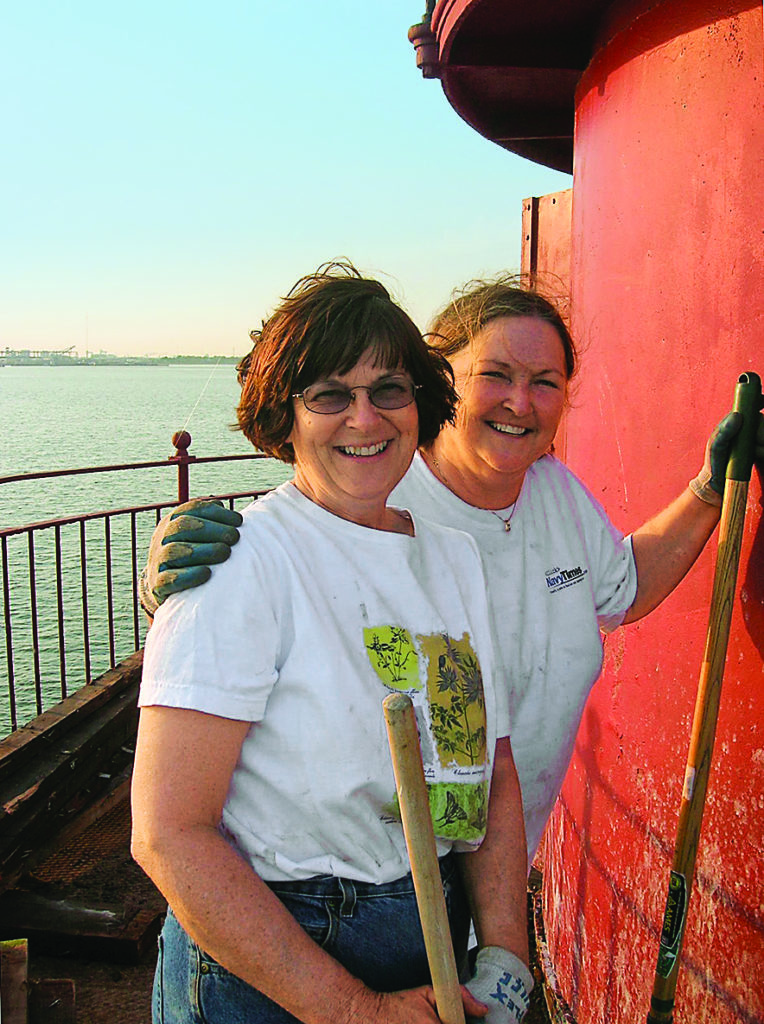
His wife, Joan, relented. “I’ve learned over the years that if I say no he pouts,” she says. The couples opened the bidding at $1,000. Nearly three years later, the two families (Joan Gonsoulin and Jackie Billingsley are sisters) boast the designer home of Bay beacons, a five-story, 1,200-square foot retreat with hand-painted murals, gleaming hardwood floors, a 42-inch plasma TV and a modular kitchen table custom-built by Joan’s and Jackie’s 86-year-old father. The table, made of century-old bald cypress salvaged from the lighthouse deck, is where the families and guests feast on freshly caught steamed crabs delivered, chez beacon, by a local waterman.
Crustaceans aren’t Middle Ground’s only import. When Joan ordered a sofa bed from a local furniture company advertising free delivery, she figured the couple would have it trucked to the house and then ferry it out on their 21-foot Parker. Not one to resist a challenge, the store owner showed up at their marina with the sofa and two burly deliverymen (neither of whom could swim). Out they went. Using the lighthouse hoist, they carefully lifted the sofa some 15 feet, wrestled it onto the main deck and then wedged it up the narrow, circular staircase to the second floor. As the sofa dangled over Hampton Roads Harbor, Joan recalls, an incredulous older couple puttered by in their boat. “Bob told them that no one would believe them if they told anyone what they’d seen.”
Jumping into lighthouse ownership is a big leap and the buyers of Middle Ground, Thimble Shoal and Smith Point lights still offer one another support and advice. For Dave McNally, who purchased Smith Point sight unseen for $170,000, having Bay connections is important. He lives in Winona, Minnesota.
The Mississippi River-raised McNally, who grew up admiring the lighthouses of the Great Lakes, was Googling “lighthouses for sale” when he discovered “the one” in Virginia. Unlike most offshore Bay beacons, Smith Point still had electric service, provided by a three-mile-long submarine power cable. (The cable has since malfunctioned, a mixed blessing for McNally, who misses the more powerful light it once generated, but not the fog horn that blasted every 17 seconds.)
A builder and lumberyard owner, McNally flies in carpenters from the Midwest to restore his lighthouse-cum-East Coast retreat. Their first order of business was replacing the front door and 14 rotted windows with facsimiles of the originals, all custom-made in McNally’s home state (“I’m one of the only people in Minnesota who’s got hurricane-proof windows”). They’re then trucked to Virginia. Another Minnesota firm built him davits, installed but not yet operating.
The Minnesotan is becoming Bay-savvy. He took sailing lessons here last year, displays a photo of the Tides Inn yacht, the Miss Ann, on his office wall and may even have an antidote the next time his son jumps off the lighthouse and encounters a sea nettle. “Hey, I’m from Minnesota,” he could only console his offspring then. “I don’t know what to do.”
What becomes of lighthouses no one wants? Thus far even the most forlorn beacons have found owners. A 1960 explosion and fire rendered tilted Bloody Point Light off Kent Island a gutted iron shell, but new owner Michael Gabriel, a Nevada attorney, considers the up side: “All the inside and outside wood is destroyed, so demolition has already been handled.” Restoration will begin, he says, once the tugboat/work barge he recently bought finishes helping out at the lighthouse he recently acquired on Delaware Bay.
Sandy Point Light, heavily vandalized and needing a $1 million makeover, was purchased by builder Daryl Wagner, who wants to restore it for personal and perhaps educational use. Wagner already owned a 45-foot private beacon that graces his controversial Little Island property (the subject of a lawsuit alleging he failed to secure proper building permits). His family has deep ties to the Magothy so the Sandy Point’s availability—even at a price of $250,000—was “the chance of a lifetime,” he says. Wagner’s dream flashed before his eyes in January, when he plopped down to watch the 11 o’clock news and saw an 800-foot cargo ship grounded within a half-mile of the beacon. “When I saw how close it came I thought, holy moly.”
Reversing nearly a half-century of decline takes time. Progress on Craighill Light has been achingly slow, Cathy Taylor concedes as we break after an hour or so of “poop deck” scrubbing, window washing and painting. When her spirits ebb as she tries to raise money for a dock and a new davit system, she tells herself “failure is not an option.” One day, when the lighthouse is fit to receive visitors again, she wants to speak for beacon-sitters before her, sharing their tales of self-sufficiency and danger and hard work tending a technology whose time is passing but whose legacy endures. And she knows her son and daughter will have their own stories to tell. “It’s something I hope they’ll remember forever,” she says, “ something fun they did with their parents.”
Once little more than blinking birdhouses, the Bay’s rescued beacons are becoming humanized again under new owners. “I know my father would be very proud of what you’re doing to restore his home,” the son of a former Coast Guard tender at Thomas Point told Henry Gonzalez. The sentiment resonated. Gonzalez discovered that his great-great-grandfather had been a lighthouse keeper on the coast of Spain, serving until he drew his last breath there in 1904. “I look at it that my great-great-grandfather is up there smiling now,” he says.
Beacons on the Block
Two more lighthouses in the middle Bay are slated to be sold by the federal government: Maryland’s Point No Point and Sharps Island lights. At press time, Point No Point bidding remained suspended at the request of the Navy. (The light marks a boundary for restricted waters.) Online bidding for Sharps Island Light is expected to open in late spring or early summer, according to a spokesman for the General Services Administration. Check www.auctionrp.com for updates.
For more information on lighthouse restorations, visit the following websites:
• Baltimore Harbor Light, www.baltimorelight.org
• Thomas Point Light, www.thomaspointlighthouse.org
• Chesapeake Chapter, U.S. Lighthouse Society, www.cheslights.org

